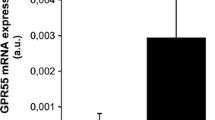Abstract
The placental circulation is crucial for the development of mammalian embryos [1]. The labyrinth layer in the placenta is created by extensive villous branching of the trophoblast and vascularization arising from the embryonic mesoderm. In the labyrinth, materials are exchanged between the maternal and embryonic circulation. Recently, we have found that inositol 1,4,5-trisphosphate (IP3) receptors (IP3Rs) may be required for the placental vascularization.
You have full access to this open access chapter, Download chapter PDF
Similar content being viewed by others
Keywords
The placental circulation is crucial for the development of mammalian embryos [1]. The labyrinth layer in the placenta is created by extensive villous branching of the trophoblast and vascularization arising from the embryonic mesoderm. In the labyrinth, materials are exchanged between the maternal and embryonic circulation. Recently, we have found that inositol 1,4,5-trisphosphate (IP3) receptors (IP3Rs) may be required for the placental vascularization.
IP3Rs are intracellular Ca2+ release channels that have three subtypes in mammals (IP3R1, IP3R2 and IP3R3) [2]. We previously showed that IP3R1 and IP3R2 played an essential role in heart development from the analysis of mouse embryo double knockout for IP3R1 and IP3R2 [3]. A previous report on the requirement for phospholipase (PLC) δ1 and δ3 [4] that produce IP3 for placentation led us to investigate the placental defects by deletion of any subtypes of IP3Rs. Our preliminary result revealed that embryonic vasculature in the labyrinth was impaired in the placenta double knockout for IP3R1 and IP3R3 at E9.25 (Fig. 32.1). The detailed phenotype and the underlying mechanism how the intracellular Ca2+ signaling via IP3Rs may be implicated in the development of extraembryonic vasculature are under investigation.
Cross sections of E9.25 placentas from the IP3R1+/−3−/− (a and b) and IP3R1−/−3−/− (c and d) mice. (b) and (d) show higher-power fields of the rectangular areas of the labyrinth in (a) and (c), respectively. Embryonic vessels (arrowheads) fail to elongate to the maternal sinuses in the placenta of IP3R1−/−3−/− compared to that of IP3R1+/−3−/− (wild type). al allantois, de decidua, gi trophoblast giant cells, la labyrinth layer, sp spongiotrophoblast layer. Scale bars, 0.5 mm in (a) and (c) and 0.2 mm in (b) and (d)
This work was supported by a Grant-in-Aid for Scientific Research from the Ministry of Education, Culture, Sports, Science and Technology, Japan (to K.U. and H.Y.).
References
Rossant J, Cross JC. Placental development: lessons from mouse mutants. Nat Rev Genet. 2001;2:538–48.
Berridge MJ, Lipp P, Bootman MD. The versatility and universality of calcium signalling. Nat Rev Mol Cell Biol. 2000;1:11–21.
Uchida K, Aramaki M, Nakazawa M, Yamagishi C, Makino S, et al. Gene knock-outs of inositol 1,4,5-trisphosphate receptors types 1 and 2 result in perturbation of cardiogenesis. PLoS One. 2010;5:e12500.
Nakamura Y, Hamada Y, Fujiwara T, Enomoto H, Hiroe T, et al. Phospholipase C-delta1 and -delta3 are essential in the trophoblast for placental development. Mol Cell Biol. 2005;25:10979–88.
Author information
Authors and Affiliations
Corresponding author
Editor information
Editors and Affiliations
Rights and permissions
Open Access This chapter is distributed under the terms of the Creative Commons Attribution-Noncommercial 2.5 License (http://creativecommons.org/licenses/by-nc/2.5/), which permits any noncommercial use, distribution, and reproduction in any medium, provided the original author(s) and source are credited. The images or other third party material in this chapter are included in the work's Creative Commons license, unless indicated otherwise in the credit line; if such material is not included in the work's Creative Commons license and the respective action is not permitted by statutory regulation, users will need to obtain permission from the license holder to duplicate, adapt or reproduce the material.
Copyright information
© 2016 The Author(s)
About this chapter
Cite this chapter
Uchida, K., Nakazawa, M., Yamagishi, C., Mikoshiba, K., Yamagishi, H. (2016). Inositol Trisphosphate Receptors in the Vascular Development. In: Nakanishi, T., Markwald, R., Baldwin, H., Keller, B., Srivastava, D., Yamagishi, H. (eds) Etiology and Morphogenesis of Congenital Heart Disease. Springer, Tokyo. https://doi.org/10.1007/978-4-431-54628-3_32
Download citation
DOI: https://doi.org/10.1007/978-4-431-54628-3_32
Published:
Publisher Name: Springer, Tokyo
Print ISBN: 978-4-431-54627-6
Online ISBN: 978-4-431-54628-3
eBook Packages: MedicineMedicine (R0)





